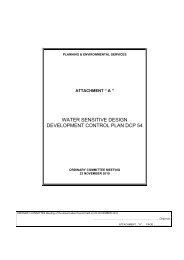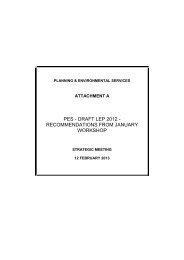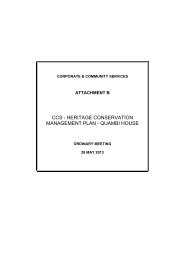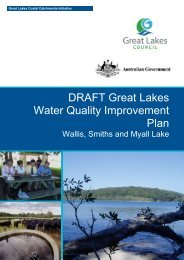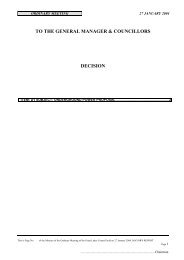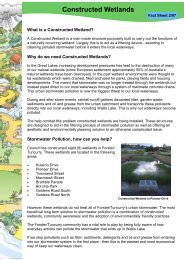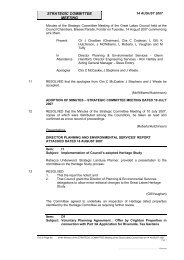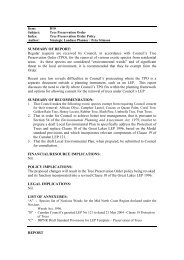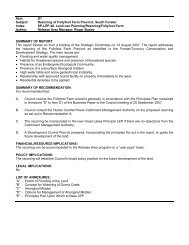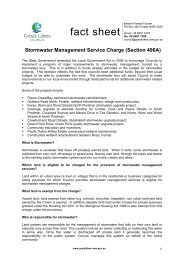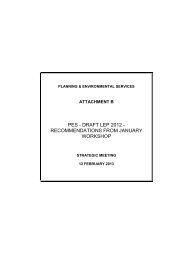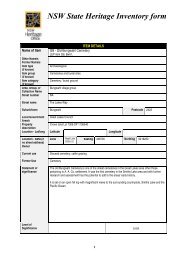smiths lake planning study volume 1: text - Great Lakes Council
smiths lake planning study volume 1: text - Great Lakes Council
smiths lake planning study volume 1: text - Great Lakes Council
You also want an ePaper? Increase the reach of your titles
YUMPU automatically turns print PDFs into web optimized ePapers that Google loves.
FLOODING AND DRAINAGE 28<br />
Based on Australian Rainfall and Runoff (IEAust, 1987), the design rainfall intensities for the<br />
SLA and SLVA are listed in Table 3-1 below.<br />
Average<br />
Table 3-1 Design Rainfall Intensities (mm/h)<br />
Duration<br />
Recurrence Interval 1 hour 12 hour 72 hour<br />
2 years 40.0 8.0 2.5<br />
50 years 76.0 13.6 4.6<br />
Regional skew is listed as 0.01 and F2 and F50 values are listed as 4.32 and 16.15 respectively.<br />
Willing and Partners (1996) states that DLWC and NSW Department of Works and Services<br />
(through Manly Hydraulics Laboratory, MHL) do not operate any gauging stations or have any<br />
data on discharge of flood levels relating to the Smiths Lake catchment.<br />
3.1.3 Groundwater Characteristics<br />
Groundwater within the <strong>study</strong> area occurs in aquifer systems within either fractured rock or<br />
unconsolidated sediments. The Department of Land and Water Conservation has indicated that<br />
there are no registered groundwater sources or bores within the <strong>study</strong> area.<br />
The Carboniferous Age rocks have been subject to considerable folding and faulting and this<br />
has resulted in a network of joints and fractures that can store and transmit water. Groundwater<br />
generally infiltrates fractures near the surface in topographically high areas and drains through<br />
the fractures and joints until it discharges into the surface drainage system. Groundwater<br />
quality within fractured rock aquifers is likely to be variable with higher salinity values in areas<br />
where the sedimentary rocks have a marine origin such as the Yagon Siltstone.<br />
Areas of unconsolidated sediment within the <strong>study</strong> area comprise:<br />
• alluvial sediments (Unit A) along drainage paths. These areas are characterised by clayey<br />
sediments and as such groundwater availability is likely to be very low.<br />
• Estuarine (Unit E) sandy and muddy sediments in low lying coastal backdune areas.<br />
Groundwater availability and quality in these areas can vary considerably due to the<br />
complex depositional history and the interaction between marine and fluviatile<br />
environments. In general, groundwater occurs as lenses of fresh water overlying denser<br />
brackish or saline waters with recharge from rainfall. Groundwater availability in these<br />
areas is likely to be restricted to low yield non potable (drinking) supplies.<br />
• Aeolian (wind blown) coastal sand beds and dunes (Unit S). These sediments are usually<br />
characterised by low salinity, high yield and potable groundwater reserves with recharge<br />
from rainfall. The extent of clean sand beds within the <strong>study</strong> area is restricted to sandhills at<br />
Sandbar. A potential constraint on groundwater usage in the Sandbar area would be the<br />
potential for salt water intrusion with over pumping.<br />
An assessment of groundwater quality is presented in Section 2.3.7.<br />
SMITHS_LAKE_PLANNING_STUDY.DOC<br />
O C E A N I C S<br />
A U S T R A L I A




